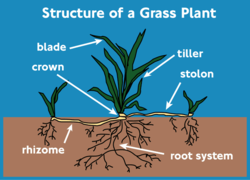AY Honors/Grasses/Answer Key
1. What characteristics must a plant have to qualify as a grass?
Grasses generally have the following characteristics (it is advisable to have a look at the image gallery for reference):
- General aspects
Poaceae have hollow stems called culms, plugged at intervals called nodes. Leaves are alternate, distichous (in one plane) or rarely spiral, parallel-veined and arise at the nodes. Each leaf is differentiated into a lower sheath hugging the stem for a distance and a blade with margin usually entire. The leaf blades of many grasses are hardened with silica phytoliths, which helps discourage grazing animals. In some grasses (such as sword grass) this makes the grass blades sharp enough to cut human skin. A membranous appendage or fringe of hairs, called the ligule, lies at the junction between sheath and blade, preventing water or insects to penetrate into the sheath.
2. What kind of roots do all grasses have?
Grasses (and several other plants) have roots called rhizomes. A rhizome is a horizontal stem of a plant that is usually found underground and often sends out roots and shoots from its nodes. Rhizomes may also be referred to as creeping rootstalks, or rootstocks. Rhizomes typically have short internodes; they send out roots from the bottom of the nodes and new vertically growing shoots from the top of the nodes.
For many plants, the rhizome acts as the "seed", and is used by humans to propagate the plants.
3. About how many species around the world are there in the grass family called Gramineae or Poaceae?
The Poaceae is also known as the Gramineae. There are about 600 genera and between 9,000 to 10,000 species of these plants. Plant communities dominated by Poaceae are called grasslands; it is estimated that grasslands comprise 20% of the vegetation cover of the earth. This family is the most important of all plant families to human economies: it includes the staple food grains grown around the world, lawn and forage grasses, and bamboo, widely used for construction throughout Asia.
4. Do the seeds of grasses have two halves as does the bean (a dicotyledon), or does the seed consist of just one part as do the lily, date, and coconut (monocotyledons)?
All grasses are monocotyledons, so the seeds have only one part.
5. What unique characteristic in the growth of grass leaves makes it possible for the plant to flourish even though continually mowed or grazed?
Grass blades grow at the base of the blade and not from growing tips. This location of the grass growing point near the ground allows it to be grazed or mowed regularly without damage to the growing point.
6. Name three annual grasses, that is, grasses that sprout from seeds, blossom, bear seeds, and then die the same summer.
- Barnyard grass (Echinochloa crus-galli)
- Crabgrass (Digitaria spp.)
- Common wild oat (Avena fatua)
- Foxtail grass (Alopecurus spp.)
7. Name three perennial grasses, that is, grasses whose roots live on from year to year, although the top dies down to the crown each autumn.
- Couch Grass (Elytrigia repens)
- Panicum (Panicum spp.)
- Fescue (Festuca spp.)
- Kentucky bluegrass (Poa pratensis)
8. In each of the following cases name a single grass, or more where indicated, from which the product is made:
a. Bread (three grasses)
Wheat, Rye, Barley, Oats, Corn
b. Brooms
Broomsedge
c. Fishing poles
Bamboo
d. Gluten
Wheat, Rye, Barley
e. Grain alcohol (two grasses)
Wheat, Rye, Corn
f. Hay
Rye, Timothy, Brome, Fescue, Coastal bermuda, Orchard grass
g. Hominy
Maize (corn)
h. Molasses
Sugarcane, Sorghum
i. Oatmeal
Oats
j. Starch
Corn, Rice, Wheat
k. Sugar
Sugarcane, Corn
l. White flour
Wheat

